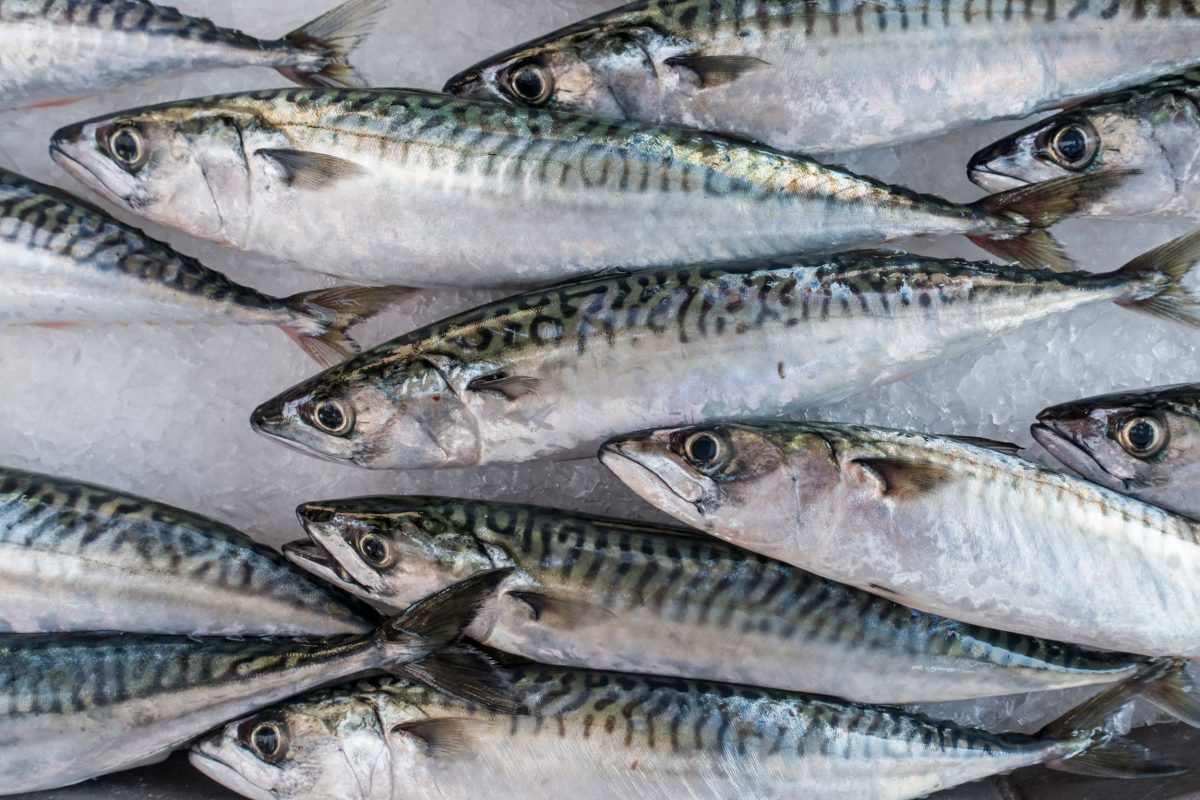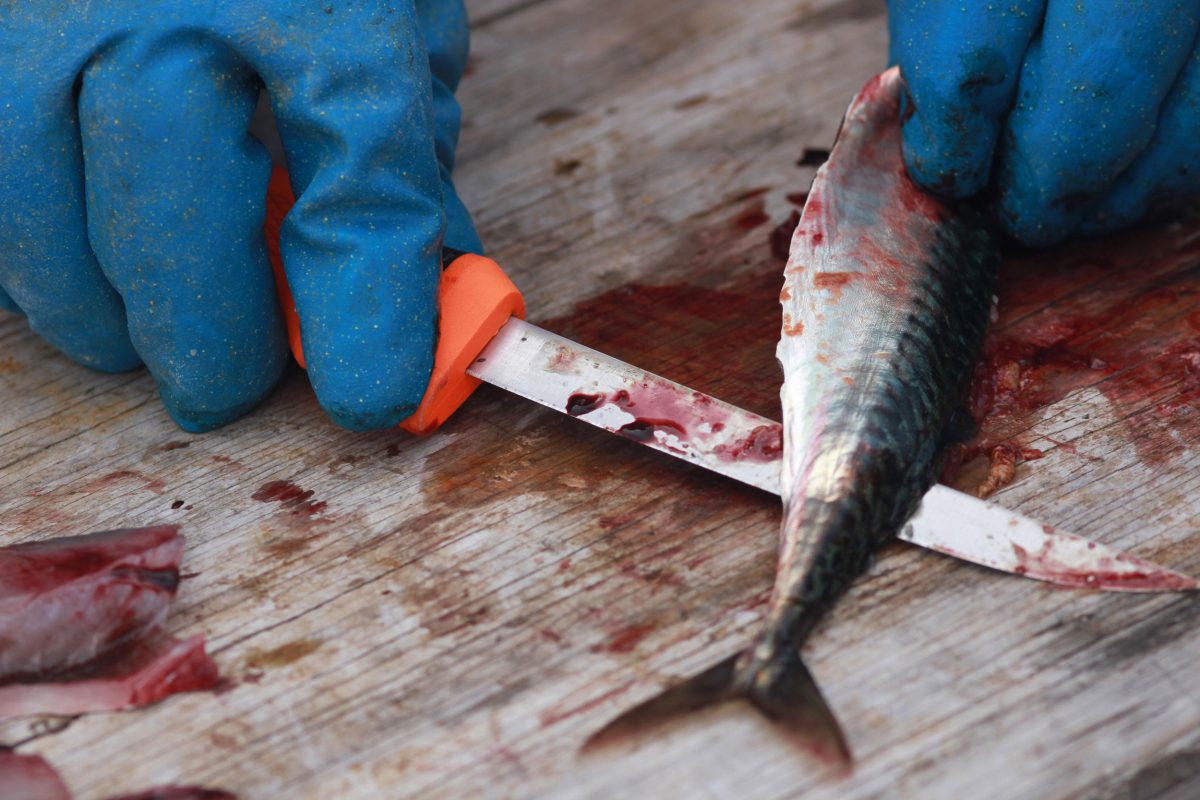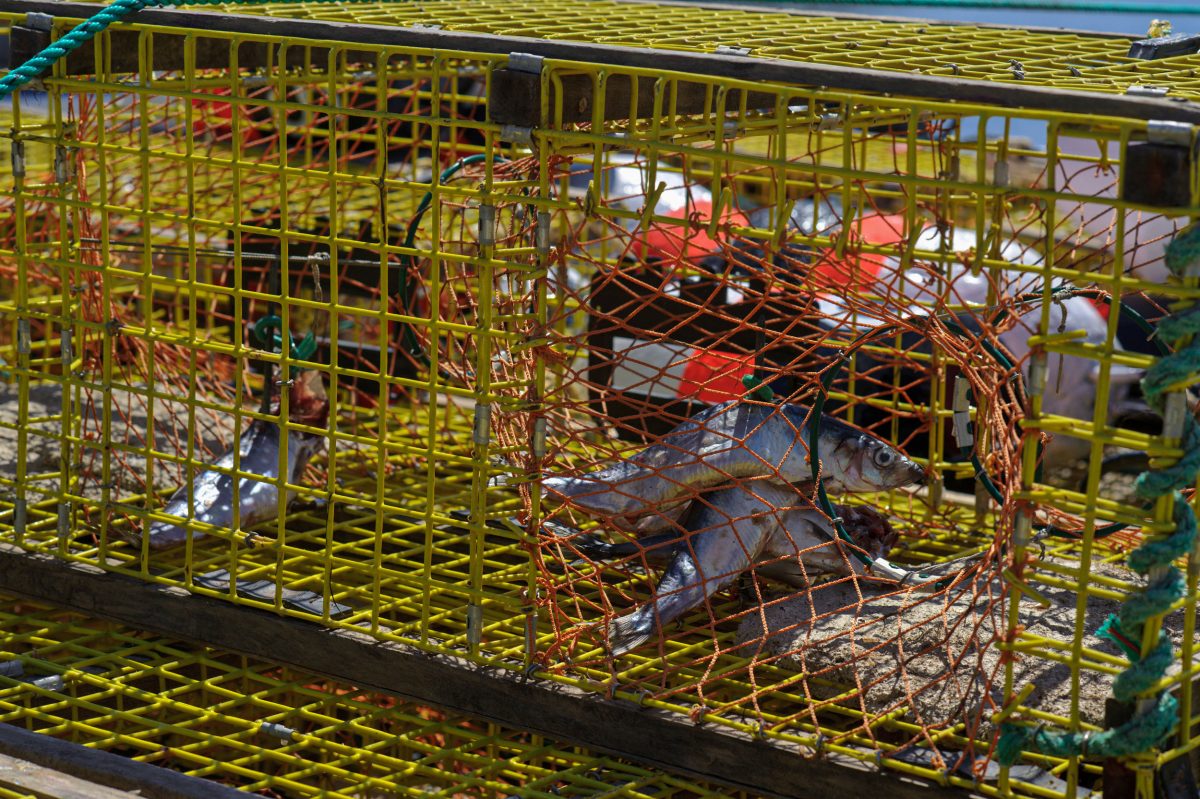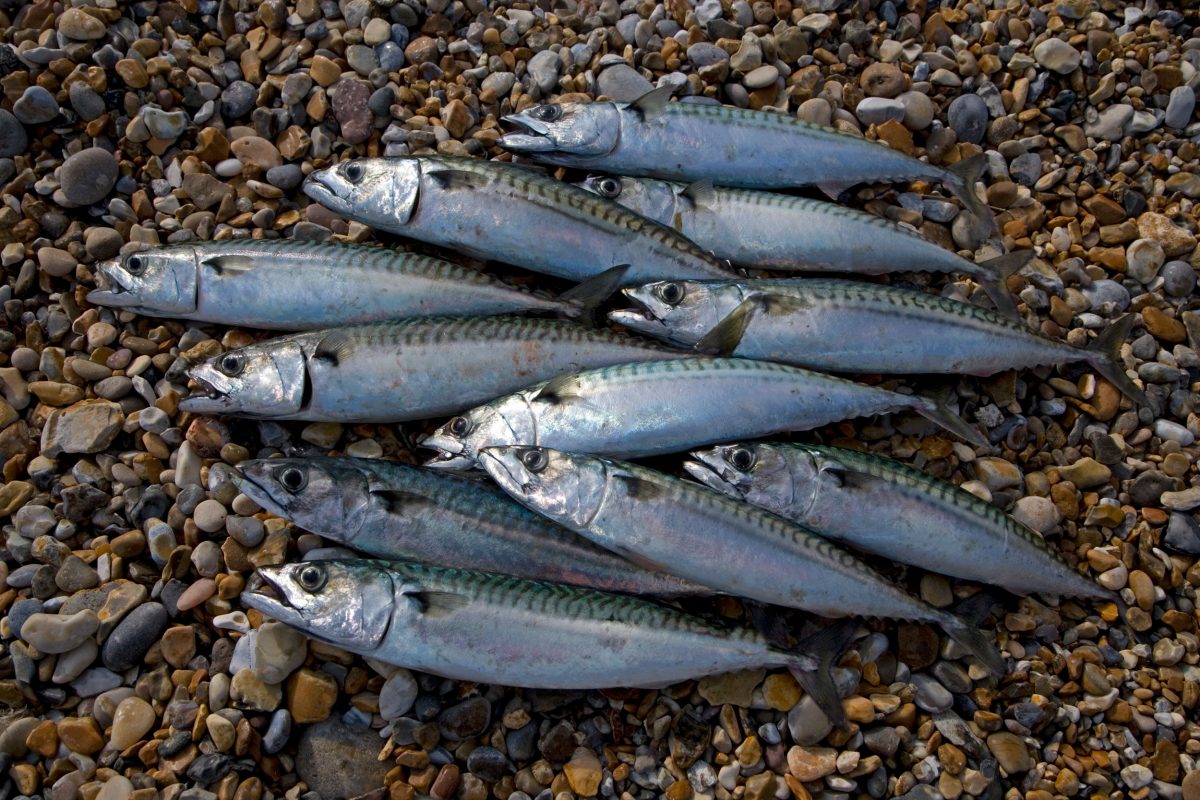Holy Mackerel, Where’d You Go?
Mackerel have an eastern and a western population in the Atlantic. This highly migratory fish is caught for food and bait in recreational and commercial fisheries and is an important link in marine food webs. Photo by Chris Gomersall/2020Vision/Minden Pictures
Authored by
byWordcount
January 18, 2022 | 3,100 words, about 16 minutesStream or download audio For this article
This article is also available in audio format. Listen now, download, or subscribe to “Hakai Magazine Audio Edition” through your favorite podcast app.
Article body copy
Summer in Atlantic Canada can be an unreliable thing, emerging reluctantly from the damp cold of spring. But a sure sign of summer’s arrival is the sudden presence of Atlantic mackerel, which first appear as the trees are becoming flush with leaves in May, and depart with the coming of cool temperatures in the fall, schooling in enormous numbers on their migration up and down the coast. Along the way, they’re often plucked from the water, with some ending up in cases on a wharf in downtown Yarmouth, a small town on the southern tip of Nova Scotia, where in July 2021 volunteers for Seafest are unloading those cases in preparation for one of the fishing festival’s most incongruously popular events: the 12th-annual mackerel toss.
As he watches preparations from behind the line of sawhorses meant to contain spectators, Dave Warner, Seafest’s former president, explains that mackerel are a logical choice for the event. They’re a local fish that often turns up on fishing lines and in frying pans in the community, but they can also be experienced as something else entirely: a slippery, hand-sized projectile for a competitor to chuck in batches of 15 as their teammate attempts to catch the fish in a plastic bucket held in outstretched arms. As the competition begins, pairs line up at either end of the wharf, two teams at a time; the first toss of the event unspools a scream from the seagulls hovering overhead, and soon, the wharf is littered with the results of throws too short or too wide, as the fish fly out of people’s grasp.
“It’s not like throwing beanbags,” Warner says with a chuckle.
Your browser does not support the video element.
The mackerel toss is one of the more unusual activities at Yarmouth, Nova Scotia’s Seafest. Video courtesy of Yarmouth & Acadian Shores
As far as fish carnage goes, the mackerel toss is pretty minimal—the competition runs through five cases of a few dozen fish each, acquired by donation from a local commercial fishing outfit—but the act of hurling mackerel by the fistful nonetheless gives an impression of almost infinite bounty. For anglers, the experience is much the same: drop a line of hooks in the water in the summer, and you’ll soon be hauling in a string of mackerel, like bunting celebrating the season.
Yet, despite how things look at the water’s edge, scientists say mackerel are undeniably on the decline; a 2021 assessment by Fisheries and Oceans Canada (DFO) found that spawning-age stock was at the lowest level ever recorded, prompting a flurry of management measures, from a 50 percent reduction in quota for commercial harvesters to a catch limit on the recreational fishery—a first for a fishery that once had no maximum catch.
For some, these changes have been hard to accept, not least because the behavior of mackerel belies their downward trajectory; as their numbers shrink, they cluster together more, creating the impression that the fish are as plentiful as ever. But the bigger adjustment may be cultural, in a region where mackerel’s abundance is woven into the fabric of everyday life, from a summertime ritual shared within families and a food distributed to elders in Indigenous communities to a source of bait for fishers supplying their own lobster and crab traps, not to mention the basis of a commercial fishery spread across the four Atlantic provinces and Quebec. Now, as mackerel populations dwindle, a fish once taken for granted has stepped into a complicated spotlight, with people wondering if their decline can be reversed, or if—as once-abundant species like the Atlantic cod have done before them—mackerel will slip away for good.
Slipping away is already something of a mackerel specialty, as they dart from their winter habitat in the deep water along the continental shelf stretching from Nova Scotia to North Carolina to their inshore summer spawning grounds. For the so-called northern contingent, from which the Canadian catch is derived, these spawning grounds are in the southern Gulf of St. Lawrence; for their southern counterpart, summer is spent on the mid-Atlantic coast up to the Gulf of Maine. (A fully separate population of Atlantic mackerel is found off the coast of western Europe.) Pursued by predators such as seals, whales, and sharks, and pursuing prey of their own like tiny crustaceans such as copepods, mackerel are constantly on the move. (They also move to stay in the “Goldilocks band” of water they can tolerate, about 7 to 16 °C.) They sink unless in motion, as they have no swim bladder, which some scientists believe is an adaptation to facilitate faster swimming.
Yet this adaptation hasn’t helped mackerel outrun their greatest predator. Mackerel have sustained an important commercial fishery in northeastern North America for hundreds of years, first for food and, more recently, largely as bait for the tuna, crab, and lobster fisheries. Starting in the 1990s, DFO scientists began sounding the alarm about the state of the stock, and by 2011, the agency declared Atlantic mackerel to be in the critical zone, a classification that means the stock is precarious. In subsequent years, dire assessments piled up, even as DFO officials continued to set quotas higher than scientists’ recommendations (including in 2014 when the quota was set at 8,000 tonnes, despite the agency’s own scientists advising it be set at just 800.)

Mackerel have a prized place in recreational and Indigenous fisheries of Atlantic Canada. Photo by Philippe Clement/Minden Pictures
Something else changed in this time, too, as researchers and advocates began to understand that the fish were in trouble. “Unfortunately, even from within the conservation community, forage fish really weren’t paid that much attention until fairly recently, when everybody got wind of the status of the stock,” says Katie Schleit, senior fisheries adviser with the conservation organization Oceans North. “I think there was this perception of a limitless abundance, which is weird, because we had a lot of lessons that that wasn’t the case, with cod and other species.”
In 2021, the true limits of that abundance became clear, when a biennial DFO assessment put the stock at just eight percent of what was in the water in the 1980s. In response, Canada’s minister of fisheries briefly shut down the spring commercial mackerel fishery, sparking protests at the wharf by fishers, only to open it back up with a reduced quota of 4,000 tonnes—a figure that also stands in stark contrast to the 1980s and ’90s, when the total allowable catch was 200,000 tonnes.
Conservationists fear that even dramatic reduction won’t be enough. “We thought that a zero commercial quota was really the only way forward scientifically,” says Schleit. That’s in part because, unlike most other species on Canada’s Atlantic coast, mackerel aren’t just the basis of a CAN $7.4-million commercial fishery. They’re also caught by Indigenous harvesters who distribute fish to community members through a food, social, and ceremonial fishery; by anglers hooking their dinners as part of a recreational fishery; and by commercial fishers harvesting their own bait all along the coastline—a legacy harvest that stems from mackerel’s traditional use. When mackerel were abundant, this wasn’t a problem. But with the population dwindling, mackerel’s myriad uses have come under scrutiny.
It’s the roe that Wendie L. Wilson remembers. Thinking of it now, the African Nova Scotian artist and community advocate can put herself right back 40 years to the kitchen of her childhood home in Halifax’s north end, waiting for the salty pop of the mackerel roe that her mother had just prepared.
“I just remember that taste and how delicate it was,” Wilson says. Most people in the family didn’t care for roe, so preparing and eating the eggs was a hot afternoon ritual that bound mother and daughter. “We had lots of people that lived in the house with us, but … when that was going on, it always seemed to be just the two of us.”
On those summer days in the late 1970s and ’80s, the fish came from the “mackerel man”—a title bestowed variously on teenaged boys and men—who passed through the predominantly African Nova Scotian community with affordable fresh fish when the mackerel were running. “You could hear him from a few blocks away, yelling ‘mackerel, mackerel.’ And we were one of the last blocks for him to come to, but my mom was a good customer, so he would always save the ones that had the roe.”
The era of the mackerel man is over, and Wilson doesn’t eat much mackerel herself these days, but she still remembers how the oily, flavorful fish would be prepared—lightly floured, seasoned with salt and pepper, and fried in a cast iron pan—before being eaten piping hot with bare fingers. And this wasn’t unique to her family; she recalls walking around the close-knit neighborhood as a child and seeing bones on the roadside that had been discarded by people snacking on fried mackerel on the fly.

Recreational fishers eat both the meat and the roe (eggs) of mackerel. Photo by Lee Brown/Alamy Stock Photo
The mackerel man may have been part of a few neighborhoods like Wilson’s, but these kinds of informal supply chains are typical of mackerel. Most of the commercial catch goes to bait; as a result, mackerel is rarely available in the grocery store (where it’s been crowded out by more neutral-tasting fish, anyhow), and mackerel for human consumption tends to come directly from individuals and communities themselves. This includes in my own family, where growing up, I would go out with my father on the water near Halifax to fill a plastic bag with a half-dozen mackerel—the only fish we could reliably catch—for the barbecue in the heady early days of summer vacation. A house up the road had a sign on the lawn offering “smoke mackerel” (a “d” was eventually added).
On the rocky coastline of Guysborough County, in northern Nova Scotia, fishers who catch mackerel commercially and harvest it for their own lobster and crab traps will also jig for the fish to distribute to family members and neighbors in the warmer months, to be cooked 10 different ways and eaten twice a week, when it’s around. “It’s a part of our diet,” says Ginny Boudreau, manager of the Guysborough County Inshore Fishermen’s Association. “So that if that wasn’t there, it would be missed for sure.” As far back as the 18th century, settlers in Nova Scotia were incorporating mackerel as part of their summertime fare; the Reverend John Seccombe, who kept a meticulous diary of his meals in 1761, noted that mackerel made a particularly good accompaniment for the cucumbers that grew abundantly in August.
Some uses go back millennia. They’re recorded in stories passed down for generations, says Tyson Paul, stories about where to fish and when—after the strawberries appear, for instance, or when the smelts are gone.

Much of the commercial mackerel harvest is used for bait, particularly in the lobster fishery. Photo by Brian Atkinson/Alamy Stock Photo
When Paul and his colleague Angela Denny led Mi’kmaw ecological knowledge workshops on the mackerel in 2019, these stories came pouring out, knowledge holders feeding off each other as they pointed out fishing locations on a map of Unama’ki, the Mi’kmaw name for Cape Breton, an island that makes up northern Nova Scotia. “They’ll start talking, ‘Oh, I used to catch here.’ Then a person would be like, ‘Yeah, me and him used to go, too, back in the day.’ So those stories, that’s where we get a lot of good, valuable information,” says Paul.
The Mi’kmaq have lived in Mi’kma’ki—the ancestral and unceded territory of the Mi’kmaw people, which covers much of eastern Canada and parts of northern Maine—for more than 10,000 years, and mackerel, or amalamek, has traditionally formed an important part of the diet, both as food and as bait.
Part of mackerel’s significance comes from its reliability, Tyson says; knowledge holders who participated in the workshop described always knowing where and when to go to catch the fish. “The ones that know how to do it, they say, ‘if we want mackerel, we can go and catch mackerel, and we’ll eat it. But if we don’t need it, then we don’t fish it, right?’” says Paul. “That’s all part of netukulimk,” he adds, referencing the Mi’kmaw concept of sustainability, which includes only taking what one needs.
But some Mi’kmaw fishers worry that unsustainable use of the stock by other groups could undermine the traditional role of mackerel.
Every summer, the Mi’kmaw community of Membertou, which is also on Unama’ki, sends a boat into the harbor to catch mackerel as part of the community’s food, social, and ceremonial (FSC) fishery. “The boys clean them and then distribute them to the elders,” says Hubert Nicholas, director of fisheries for Membertou First Nation.
Thirty years ago, a Supreme Court of Canada ruling affirmed the rights of Indigenous communities to fish for FSC purposes; this is different from the recreational fishery for non-Indigenous people, although the fish also can’t be sold.
Nicholas says the community also holds a couple of commercial bait licenses that aren’t worth fishing any more—the mackerel are too small to justify the effort. This means the community has had to start importing mackerel, at a premium, from other countries to use as bait—but Atlantic mackerel nonetheless remain important as a food source through the FSC fishery. Now, he worries that the depleted state of the stock may eventually infringe on his community’s right to fish mackerel for that purpose. “Our right is basically, we could take any species as required if there’s no conservation concerns. But how are we supposed to do that, when DFO mismanages it to the point where every species has conservation concerns?”
In a statement, DFO says it is committed to managing the mackerel fishery sustainably, and that “Indigenous groups will continue to have priority access for food, social, and ceremonial fisheries in all mackerel fishing areas.”
Fitting this complicated picture—the commercial activity, the Indigenous fisheries, the bait harvest—into a more rigid regulatory structure has been challenging, including at the level where most people engage with mackerel on an everyday basis, through recreational use. In 2021, DFO introduced a limit on the recreational fishery for the first time: 20 mackerel per person per day, in a fishery that once had no limits. The new regulations are actually designed to close a loophole, whereby commercial license holders were dodging regulations by fishing under the guise of the recreational fishery. True recreational fishing likely represents a fraction of the total catch, but the change signaled something important to communities nonetheless—that a fish used for so many purposes could no longer be taken for granted.
Even at 2021’s restrictions and reduced quota, the recovery of Atlantic mackerel is a coin toss—depending on how many fish survive their first year in the years to come, DFO scientists estimate there’s either a four-or-five-out-of-ten chance that the stock will climb its way out of the critical zone by 2023.
Complicating the picture is the fact that the mackerel population isn’t just smaller—it’s also younger, due to overfishing. “Atlantic mackerel can live up to 20 years, whereas in recent years, and I’m talking about at least a couple of decades, it’s hard to find mackerel over 10,” says Andrew Smith, a stock assessment biologist with DFO. Lately, Smith says, you’d be hard-pressed to find a mackerel older than five—a particular concern, since mackerel don’t start reproducing until age two at the earliest, and older, fatter female fish have the greatest reproductive potential. Yet, while overfishing got mackerel into this mess, ending fishing alone won’t get them out of it. Mackerel are highly sensitive to conditions such as water temperature and food availability, and with the stock in such a precarious state, fluctuations have an outsized impact on the health of the population. As climate change drives further environmental shifts in the North Atlantic, where severe changes are already happening, mackerel have more challenges ahead, challenges that are difficult to predict and may be even harder to manage.

It is hoped that new regulations on commercial and recreational fisheries put in place by Fisheries and Oceans Canada will give beleaguered Atlantic mackerel stocks a chance to rebound. Photo by Ernie Janes/Minden Pictures
Nonetheless, removing pressure from fishing could give mackerel a better chance of rebounding. DFO has stated that the commercial fishery may be shut down if the stock doesn’t recover. This could ultimately benefit fishers by allowing for a more sustainable mackerel fishery down the road.
In the meantime, recovery will also need to involve finding alternatives for the fisheries that depend on mackerel for bait and convincing those working in these fisheries to adopt them—whether those alternatives are invasive species such as green crab, or substitutes like the one made partly from fish byproduct by a Prince Edward Island fisher who was frustrated with using a kilogram of mackerel to catch half as much lobster.
As for the recreational fishery, the days of unrestricted catches are likely over. But in this new, constrained reality, there’s the chance for a greater sense of stewardship.
On a breezy evening in mid-July, a municipal wharf on the Halifax Harbour is dotted with anglers, dropping mackerel lures into the blue-green water as the city’s ferry trundles past. Mark George has been coming to this spot for at least a decade; he has one mackerel in the cooler at his feet and is casting for another to complete his evening meal, after having already come to the wharf at dawn to catch mackerel for his nonagenarian neighbor.
Even here, the specter of mackerel’s decline is impossible to ignore. In the years he’s been coming to the wharf, George says he’s seen the schools and the individual mackerel shrink. “It’s like the cod,” he says. “You can’t just keep taking them.”
In this moment, though, the mackerel are still biting, and after a few minutes, the tip of George’s rod dips. He reels in a mackerel, flashing silver on the line, and grabs the fish, bracing it against the wharf. As he gently removes the hook, he explains that after seeing some of the other anglers on the wharf flicking their hooks to send undersized mackerel back into the water, he’s started educating them on a less harmful technique—a role he’s adopted happily enough, along with the new restrictions on how many mackerel he can take home from the wharf, if it means there’ll be fish to catch in the years to come.
George, and the thousands of people who benefit from mackerel in the region, are part of mackerel’s past, but by changing how they benefit, they could also be part of mackerel’s future. And while the challenges facing mackerel are not unique to the species—with other forage fish such as herring and capelin experiencing steep declines—the same ubiquity that once drove mackerel’s decline could also be harnessed to bring it back from the brink; people may have taken mackerel for granted, but you can be sure they’d notice if they were gone. Avoiding that outcome means changing the trajectory while mackerel are still common enough to be missed—and before they slip completely into the memory of summers past.
Article footer and bottom matter
Sign up for the weekly newslstter
Sign up for our weekly newsletter
Additional Contributors
Edited by:
Adrienne Mason
Fact Checked by:
Sierra Juarez
Author bio
Moira Donovan is an independent journalist and radio producer based on the East Coast of Canada, with a body of work focused on the environment and climate change. Her work has appeared in the Christian Science Monitor, Vice, and The Walrus, and has aired on CBC Radio.

Tags
Topic:
Geographic Region:
North AmericaOceanographic Region:
Atlantic OceanSpecies:
Scientific Field/Discipline:
Cite this Article:
Cite this Article: Moira Donovan “Holy Mackerel, Where’d You Go?,” Hakai Magazine, Jan 18, 2022, accessed January 20th, 2022, https://hakaimagazine.com/features/holy-mackerel-whered-you-go/.
By accepting you will be accessing a service provided by a third-party external to https://oc3anclub.com/

